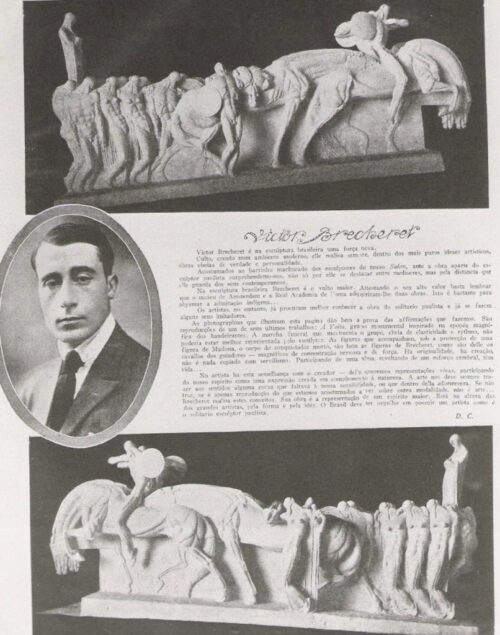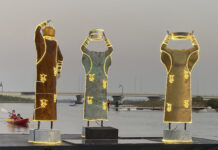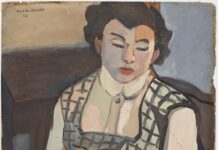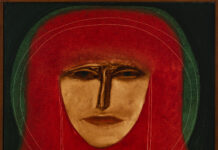
O Monument to the Flags, by Victor Brecheret, also known as Push-push and let me push, is more than a hundred years old, if we take into account that its first model dates from 1920. Located in the main park of the city of São Paulo – Ibirapuera – it and its image serve as a support for various layers of the population to project their desires and fantasies. about the city and its past, about Brazil and its future.
Carved from 240 granite blocks and weighing many tons, the Monument it does not symbolize, or does not only symbolize, the “saga” of the pioneers from São Paulo who, in the colonial period, invaded the territory of the then Portuguese colony, expanding its limits while preying on indigenous people and searching for gold and precious stones; The Monument also, since before the beginning of its construction, in 1936, it symbolized the São Paulo elite of the 20th century, identified with those supposed ancestors. In the 1930s, when the Monument begins to be erected, it was, for this elite, the symbol of its own re-emergence as a power within the nation, after the debacle of the 1930 Revolution and the Constitutionalist Revolution of 1932, when São Paulo lost its hegemony.
However, the Monument meant and means more. Although he remains undaunted there in Ibirapuera, intact in its stone concreteness, each generation, each social group tends to give it new meanings, updating it and questioning its presence in the daily life of the city.
This text should be read as the outline of an overview of how the Monument has been noticed by people from São Paulo and Brazilians, from its first models, made in 1920, to the present day.

***
Its construction began in 1936, it was quickly compromised, both by the coup that would establish the Estado Novo, in 1937, and by the outbreak of World War II, two years later. Such events helped to delay the execution of the work and only the changes that occurred after 1945[1] caused the construction of Monument was resumed, until it was inaugurated in 1953, starting the festivities of the 400th anniversary of São Paulo[2].
Brazilians in general, and São Paulo in particular, adopted the Monument to the Flags as a symbol of the city, the state and Brazil, and such positioning can be seen by its rapid transformation into a scenario for everyone to perform as members of a country that reached its future: since its inauguration, the Monument serves as a backdrop for photos that celebrate meetings between colleagues, family members and groups of tourists enchanted by the “strength” of the city. It has always been common for newlyweds just out of the wedding ceremony to pose in front of the Monument: the couple – the cell of the family and, therefore, of the country – with one of the greatest symbols of the homeland in the background.
The image of the Monument to the Flags was not restricted to the background of photos of meetings between people from São Paulo and tourists – a function that more recently would be exacerbated with the arrival of the selfies. O Monument also fueled the city's souvenir industry, imposing a memorabilia that, always with the image of the Monument, illustrates covers of notebooks, trays, key rings, dish towels, etc.[3]
***
A little over ten years after the inauguration of the MonumentHowever, the civil-military coup of 1964 made faith in the country's present and future moot. The protagonists of the new regime tried to instrumentalize the image of the Monument, relating it to the climate “Brazil, love it or leave it”. Thus, little by little, that sculptural ensemble was associated with the power that ruled the country and its role until then full of positivity began to fall apart.

As a symbol of a utopia (for few, it is true), the Monument to the Flags became one of the symbols of the dystopia that Brazil had become during the 1960s/70s – and this unedifying dimension gained visibility in works of art, such as Proposal for Monudentro, 1973 (publication On/Off 2) and Brazil Today, Natural Beauties, 1977, both by Regina Silveira.
In the following decade, with the beginning of the political opening, the symbolic dimension of the Monument was even revised, projecting a Brazil in transformation, in which the “Brazilian people” – represented by the figures of the Monument - rebelled against status quo –, case of HQ Tickets and flags, by Luiz Gê, from 1985[4].
But this trend did not continue.
Entering the 1990s and then the new century – and with the emergence of other voices in the field of Brazilian democracy – different interpretations were added to the Monument. For these new protagonists, it was necessary to make it clear that the Monument to the Flags it did not represent the glory of the country's past and future; he, in fact, honored murderous militiamen, rapists, and human traffickers.
If until then the Monument had been used only as an image and/or backdrop for the most diverse celebrations, now it also became a specific framework and support for activities to contest the established power, seen as discriminatory and cruel in relation to the subordinate segments of Brazilian society.
The demonstration that took place in São Paulo, on October 2013, XNUMX, in favor of the demarcation of indigenous lands – and which culminated in the seizure of the Monument to the Flags by the protesters – is emblematic. There, symbolically, indigenous peoples and other segments of society turned Brecheret's work into a symbol of Brazilian ignominy, a sense that was later equally felt by the production of some young artists from the city, such as Sidney Amaral, Jaime Lauriano and Flávio Cerqueira.[5].

***
Having established this panorama, it would be important to reflect on what led the Monument to the Flags to gain this prominence within the Brazilian imagination. What would be special in its design, what would be so original in its form, capable of explaining the protagonism that it has reached over time, protagonism this protagonism for good and for evil.
The most important element of that sculptural ensemble is perhaps the sensation of movement produced by Brecheret, making it seem that the entire group “walks” forward and upwards. This solution proposed by the artist synthesizes the very theme of the work, introjecting in the granite the shudder of the pioneers' entrances into the Brazilian sertão and, by association, the paulistas of the 1930s, commanding, once again, Brazil towards the future. Without individualizing any character in particular, Brecheret joined pairs or small groups that, together, seem to walk. This solution, in turn, gave it a horizontal character, underlined by the subtle elevation of the figures at the beginning. This feature brings originality to the Monument to the Flags compared to other monuments from the late 19's and early 20's, produced here and abroad. if not Monument what stands out is its horizontal character and its movement, in the conception of its congeners, verticality and immobility prevail[6].
***
If we pay attention to the photographic documents of the model for the Monument, dating from 1920, we will see that Brecheret did not make just one model, but two: the first, called Monument to the Flags, as far as is known, would have been the only one to receive a descriptive memorial, published in the magazine Paper and Ink, in July 1920, signed by the artist[7]. However, in September of the same year, in the magazine Brazilian illustration, in addition to the aforementioned model, two photos of a second model were published, this one referring to the monument the turn. The photos illustrated a brief article entitled “Victor Brecheret”, signed with the initials D.C., with a photo of the then young sculptor.

Although under another title, the turn it was also a project for a monument dedicated to flags and pioneers, as we can see from the columnist's words:
These are reproductions of his latest works: the turn, a monumental group inspired by the magnificent epic of the pioneers. The funeral march that moves the group, full of elasticity and rhythm, could not have been better represented by the sculptor. The figures that accompany, under the protection of a Madonna figure, the body of the dead conqueror, are very similar to Brecheret's figures, as are his handlebar horses – magnificent in terms of nervous concentration and strength. There is originality, there is creation, nothing is copied with servility. Participating in a soul, resulting from a brain effort, they have life...[8]
***
The model that received the “Descriptive Memorial”, stands out from the other versions that, in the future, the sculptor would make of his project of the Monument to the Flags, precisely because of the role it gave to the staggered pedestal created to place the main group. This element replicates the tradition of the monuments of the late 19th and early 20s, to some extent diluting the emphasis on horizontality given to the main group, as well as its slightly ascending character. On the other hand, the pedestal placed the allegorical figures of the Brazilian Land, the “Guarda Ânfora” (which was supposed to hold a container with water from the Tietê River) and the insidies that haunted the pioneers during their travels through the interior. As can also be seen, the figure of a Victory (which the columnist calls Madonna) was sketched on the bandeirantes – another device of the more conventional statuary.
***

Raul Polllo, the critic of Commerce Newspaper during the 1920s, pays attention to some facts concerning the model of the Monument to the Flags, and the other one, produced by the artist for the contest for Monument to the Andradas, which would take place in Santos, SP, also in 1920. Writing about the model that the sculptor conceived for this competition, Polillo will pay attention to Brecheret's repetition of certain elements that appeared both in this model and in the one dedicated to the Bandeiras:
In this “model” it is easy to notice a perfect analogy of conception and construction with the “model” already exposed in this Capital and destined to the commemoration of the “Bandeirantes”.
There are the same horses there, but increased in number by the same winning figure, a very similar game of figures, and an identical adaptation of symbols.[9]
After giving negative considerations to the artist's attitude in transferring solutions from one model to another, Polillo provides important information: “We know from a reliable source that the 'model' of Santos was executed before the project for the Bandeirantes”[10].
This data is significant because it corroborates the hypothesis raised in another text, in which I stated that Brecheret, between 1920 and 1936, did not stop plastically discussing certain formal elements, perceived in his first models for the Monument to the Flags, transforming or merging them with each new project, sharpening their conception from a continuous making and remaking of models and drawings, making their formal conception more and more precise.[11] Polillo, with his criticism of Brecheret's concomitant use of identical forms, both in one model and in another, only emphasizes how much the sculptor, when choosing certain plastic problems, developed them from one model to another.[12].
***

In the monument design The return, the development of some ideas that appeared in the model of the Monument to the Andradas and Monument to the Flags, and introduces others that, later, will be developed until the definitive project, of 1936. The horizontality and the ascending movement of the set are radicalized, if compared with the Monument to the Flags. The stylization of the figures also moves towards a more pronounced synthesis and, it seems, is when the artist adds to the project as a whole the elements that will transform the Monument to the Flags in a funeral procession.
In 1921, already in Paris, Brecheret conceived another model – Fragment of the Temple of my race[13]. Despite bringing some singularities that will not be developed later by the artist, the permanence of the barge and the winged Vitória stands out – in addition to the profound formal stylization.
In the study for the implementation of Monument in Ibirapuera Park, dating from 1936, it is noted that it was placed on a staggered plinth, in the middle of a rectangular square, whose monumental entrances were guarded by four colossal sculptures representing indigenous people. The allegory of the Brazilian Land, placed at the front of the set, was still present in this version.
There is also a photographic record of a last model for the Monument in which the staircase persists, but the allegorical figure of the Brazilian Land disappears. Subsequently, the artist makes a fundamental decision for the final configuration of the Monument: removes the staggered pedestal, making the ensemble appear to spring directly from the ground, which emphasizes the work's paradoxical qualities: it imposes itself as a modern monument, insofar as it is stripped of a pedestal, merging horizontality (another fact typical of modern sculpture) and upward movement; at the same time, however, it retains an aspect of ahistorical archaism, in an interpretation of the sculptural work, typical of that period.

***
As I hope I have made clear, the project of the Monument to the Flags it should not be seen from a romantic perspective, which understands the artist almost as a divine being, capable of, from nothing, or very little, conceiving a work of the size of this group; on the contrary, the Monument to the Flags it is the result of a process in which Brecheret, with all his talent and perseverance, advanced his ideas, went back, went forward again, until he reached the formal result that we can enjoy today in Parque Ibirapuera.
I hope, in some way, that I have also contributed so that we can better understand the reasons that led to the Monument to gain so many meanings, since its first model: homage to the old pioneers and the “new” ones; symbol of a city and a country that believed itself doomed to the future; then, symbol of a militarized country; symbol of Brazilian ethnic genocide. In the end, whether we like it or not Monument to the Flags, the fact is that it embodies all these possibilities of interpretation, precisely because Brecheret, with a lot of work, managed to transform that set of granite blocks into an immense signifier at the mercy of the meanings that each generation and social groups add to it.
To conclude this panorama, I would like to allude to the role that the Monument it served as a matrix for other works of art, even before its completion, in the first half of the 1950s – which informs a lot about its potency.
Although this is a topic to be duly explored, I am sure that it would be appropriate here to at least allude to the works of two artists that may be indicators of another type of impact caused by the Monument in the local imagination.

The first work that demonstrates the impact that Brecheret's proposal had on some artists, even before it was finished[14], is the untitled relief by Antelo Del Debbio, produced in the 1930s and today belonging to the MAC USP collection. As the scholar Luciano Migliaccio has already pointed out,[15], it is visible how the relief behaves as a free adaptation of Brecheret's original project, a characteristic evidenced by the emphasis on horizontality and the upward movement of the bow also represented (where the figure of a bandeirante is located).
In addition to these characteristics, attention is paid to the fact that there, all the “races” that formed Brazil are represented “behind” the figure of the bandeirante (as in Monument). On the other hand, the figure of Mother Earth or the Brazilian Earth is also evident. If in the final resolution of the Monument to the Flags, Brecheret decided to expel the figure from the set, it is interesting how Del Debbio kept it candidly lying down, placing it at the other end of the relief, in front of the stern of the vessel, candidly lying down.
The second artist to be remembered here is Livio Abramo who, in 1940, created a series of illustrations for the book by Cassiano Ricardo, March to the West[16].
Abramo did not just take Brecheret's proposal for the development of his images; productions by Debret, Portinari, Segall and Tarsila also served as the basis for their productions that recontextualized images produced by those artists.

In three illustrations for the book, Abramo “naturalizes” once and for all the allusion to the movement of the whole of the Monument to the Flags, making use of the same strategy to, in the two-dimensional plane, situate the action of the bandeirantes, understood as a set of attacks against the limits imposed on the then Portuguese colony by the Treaty of Tordesilhas, signed in 1494, by the Spanish and Portuguese governments in that city in Spain.
***
All the questions raised here only attest to what has already been explained: despite the fact that its original model is already centenary, the Monument to the Flags still supports a series of studies that develop not only the process of its production, but also the various nuances of reception that it has been (and has been) receiving over time.
This is one of the great trumps of the history of art: to be always contemporary, and this is because its object of study is stuck to the present, even when produced decades or centuries ago, and even when the historian pretends not to perceive this fact, falsely believing, who only studies works from the past.















